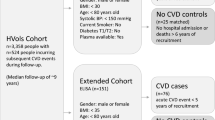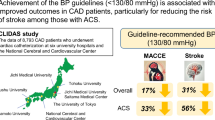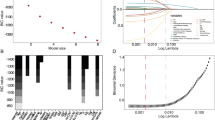Abstract
Hypertension has been associated with increased case-fatality rates among individuals who subsequently suffer from acute coronary events. It is unknown whether inflammation modifies this relationship. This population-based study explored the effects of inflammation and hypertension on incidence of coronary event, and on the fatality of the future events. Blood pressure (BP) and five inflammation-sensitive plasma proteins (ISPs, fibrinogen, orosomucoid, α1-antitrypsin, haptoglobin and ceruloplasmin) were determined in 6071 healthy men. During the mean follow-up of 19 years, 679 men had a first coronary event (non-fatal myocardial infarction or death from coronary heart disease). Of them, 197 (29%) were fatal cases (death during the first day). As expected, hypertension was associated with increased incidence of coronary events and increased proportion of fatal cases. At all levels of BP, high ISPs (⩾2 ISPs in top quartile) significantly added to the incidence of events. Men with high ISPs had the highest case-fatality rates. The difference in case-fatality rate between men with and without high ISPs was, however, significant only in men with normal BP (<130/85 mm Hg) (33 vs 19%, P<0.05), and not in men with moderate or severe hypertension (⩾160/100 mm Hg) (40 vs 35%, P=0.32). High ISPs add to the incidence of coronary events at all levels of BP. Hypertension and inflammation are both independently associated with increased case-fatality in subjects who later have an acute coronary event. The influence of ISPs on the case-fatality rate seems to be most important in men with normal BP.
This is a preview of subscription content, access via your institution
Access options
Subscribe to this journal
Receive 12 digital issues and online access to articles
$119.00 per year
only $9.92 per issue
Buy this article
- Purchase on SpringerLink
- Instant access to full article PDF
Prices may be subject to local taxes which are calculated during checkout

Similar content being viewed by others
References
Lewington S, Clarke R, Qizilbash N, Peto R, Collins R . Prospective Studies Collaboration. Age-specific relevance of usual blood pressure to vascular mortality: a meta-analysis of individual data for one million adults in 61 prospective studies. Lancet 2002; 360: 1903–1913.
Kannel WB, Doyle JT, McNamara PM, Quickenton P, Gordon T . Precursors of sudden coronary death. Factors related to the incidence of sudden death. Circulation 1975; 51: 606–613.
Kannel WB, Sorlie P, Castelli WP, McGee D . Blood pressure and survival after myocardial infarction: the Framingham study. Am J Cardiol 1980; 45: 326–330.
Njolstad I, Arnesen E . Preinfarction blood pressure and smoking are determinants for a fatal outcome of myocardial infarction: a prospective analysis from the Finnmark Study. Arch Intern Med 1998; 158: 1326–1332.
Wannamethee G, Whincup PH, Shaper AG, Walker M, MacFarlane PW . Factors determining case fatality in myocardial infarction ‘who dies in a heart attack’? Br Heart J 1995; 74: 324–331.
Rasmussen S, Abildstrom SZ, Rosen M, Madsen M . Case-fatality rates for myocardial infarction declined in Denmark and Sweden during 1987–1999. J Clin Epidemiol 2004; 57: 638–646.
Engström G, Janzon L, Berglund G, Lind P, Stavenow L, Hedblad B et al. Blood pressure increase and incidence of hypertension in relation to inflammation sensitive plasma proteins. Arterioscler Thromb Vasc Biol 2002; 22: 2054–2058.
Bautista LE, Vera LM, Arenas IA, Gamarra G . Independent association between inflammatory markers (C-reactive protein, interleukin-6, and TNF-alpha) and essential hypertension. J Hum Hypertens 2005; 19: 149–154.
Chae CU, Lee RT, Rifai N, Ridker PM . Blood pressure and inflammation in apparently healthy men. Hypertension 2001; 38: 399–403.
Engström G, Lind P, Hedblad B, Stavenow L, Janzon L, Lindgärde F . Long-term effects of inflammation-sensitive plasma proteins and systolic blood pressure on incidence of stroke. Stroke 2002; 33: 2744–2749.
Kervinen H, Palosuo T, Manninen V, Tenkanen L, Vaarala O, Manttari M . Joint effects of C-reactive protein and other risk factors on acute coronary events. Am Heart J 2001; 141: 580–585.
Sakkinen P, Abbott RD, Curb JD, Rodriguez BL, Yano K, Tracy RP . C-reactive protein and myocardial infarction. J Clin Epidemiol 2002; 55: 445–451.
Blake GJ, Rifai N, Buring JE, Ridker PM . Blood pressure, C-reactive protein, and risk of future cardiovascular events. Circulation 2003; 108: 2993–2999.
Engström G, Lind P, Hedblad B, Stavenow L, Janzon L, Lindgärde F . Effects of cholesterol and inflammation-sensitive plasma proteins on incidence of myocardial infarction and stroke in men. Circulation 2002; 105: 2632–2637.
Kuller LH, Tracy RP, Shaten J, Meilahn EN . Relation of C-reactive protein and coronary heart disease in the MRFIT nested case-control study. Multiple risk factor intervention trial. Am J Epidemiol 1996; 144: 537–547.
Koenig W . Fibrin(ogen) in cardiovascular disease: an update. Thromb Haemost 2003; 89: 601–609.
Engström G, Hedblad B, Stavenow L, Tyden P, Lind P, Janzon L et al. Fatality of future coronary events is related to inflammation-sensitive plasma proteins: a population-based prospective cohort study. Circulation 2004; 110: 27–31.
Gabay C, Kushner I . Acute-phase proteins and other systemic responses to inflammation. N Engl J Med 1999; 340: 448–454.
Engström G, Site-Flondell D, Lindblad B, Janzon L, Lindgärde F . Risk of treatment requiring peripheral arterial disease is related to inflammation-sensitive plasma proteins. A prospective cohort study. J Vasc Surg 2004; 40: 1101–1105.
Engström G, Börner G, Lindblad B, Janzon L, Lindgärde F . Incidence of fatal or repaired abdominal aortic aneurysm in relation to inflammation-sensitive plasma proteins. Arterioscler Thromb Vasc Biol 2004; 24: 337–341.
Berglund G, Eriksson KF, Israelsson B, Kjellström T, Lindgärde F, Mattiasson I et al. Cardiovascular risk groups and mortality in an urban Swedish male population: the Malmö Preventive Project. J Intern Med 1996; 239: 489–497.
The sixth report of the Joint National Committee on prevention, detection, evaluation, and treatment of high blood pressure. Arch Intern Med 1997; 157: 2413–2446.
Laurell CB . Electroimmuno assay. Scand J Clin Lab Invest Suppl 1972; 124: 21–37.
Engström G, Berglund G, Göransson M, Hansen O, Hedblad B, Merlo J et al. Distribution and determinants of ischaemic heart disease in an urban population. A study from the myocardial infarction register in Malmö, Sweden. J Intern Med 2000; 247: 588–596.
The National Board of Health and Welfare. Värdering av diagnoskvaliten för akut hjärtinfarkt i patientregistret 1987 och 1995 (in Swedish). Stockholm: Sweden, 2000.
Hansen O, Johansson BW . Epidemiologic aspects of coronary heart disease in Malmo, Sweden, 1935–1988. Am J Epidemiol 1991; 133: 721–733.
Pacifico A, Henry PD . Structural pathways and prevention of heart failure and sudden cardiac death. J Cardiovasc Electrophysiol 2003; 14: 764–775.
Lip GY, Felmeden DC, Li-Saw-Hee FL, Beevers DG . Hypertensive heart disease. A complex syndrome or a hypertensive ‘cardiomyopathy’? Eur Heart J 2000; 21: 1653–1665.
Egashira K, Suzuki S, Hirooka Y, Kai H, Sugimachi M, Imaizumi T et al. Impaired endothelium-dependent vasodilation of large epicardial and resistance coronary arteries in patients with essential hypertension. Different responses to acetylcholine and substance P. Hypertension 1995; 25: 201–206.
Chung MK, Martin DO, Sprecher D, Wazni O, Kanderian A, Carnes CA et al. C-reactive protein elevation in patients with atrial arrhythmias: inflammatory mechanisms and persistence of atrial fibrillation. Circulation 2001; 104: 2886–2891.
Rozanski GJ, Xu Z . A metabolic mechanism for cardiac K+ channel remodelling. Clin Exp Pharmacol Physiol 2002; 29: 132–137.
Korantzopoulos P, Kolettis T, Siogas K, Goudevenos J . Atrial fibrillation and electrical remodeling: the potential role of inflammation and oxidative stress. Med Sci Monit 2003; 9: RA225–RA229.
Sajadieh A, Nielsen OW, Rasmussen V, Hein HO, Abedini S, Hansen JF . Increased heart rate and reduced heart-rate variability are associated with subclinical inflammation in middle-aged and elderly subjects with no apparent heart disease. Eur Heart J 2004; 25: 363–370.
Kannel WB . Silent myocardial ischemia and infarction: insights from the Framingham Study. Cardiol Clin 1986; 4: 583–591.
Engström G, Hedblad B, Stavenow L, Lind P, Janzon L, Lindgärde F . Inflammations-sensitive plasma proteins are associated with future weight gain. Diabetes 2003; 52: 2097–2101.
Best LG, North KE, Tracy RP, Lee ET, Howard BV, Palmieri V et al. Genetic determination of acute phase reactant levels: the strong heart study. Hum Hered 2004; 58: 112–116.
Acknowledgements
This work was supported by grants from the Swedish Heart and Lung foundation, the Swedish Research Council, Foundation for Research in Diabetes and Vascular Diseases and Syskonen Svenssons foundation.
Author information
Authors and Affiliations
Corresponding author
Rights and permissions
About this article
Cite this article
Engström, G., Hedblad, B., Janzon, L. et al. Fatality of acute coronary events in relation to hypertension and low-grade inflammation: a population-based cohort study. J Hum Hypertens 20, 581–586 (2006). https://doi.org/10.1038/sj.jhh.1002037
Received:
Revised:
Accepted:
Published:
Issue date:
DOI: https://doi.org/10.1038/sj.jhh.1002037
Keywords
This article is cited by
-
Treatment with captopril abrogates the altered expression of alpha1 macroglobulin and alpha1 antiproteinase in sera of spontaneously hypertensive rats
Proteome Science (2012)
-
New insights into complement C3 and inflammation in hypertension
Journal of Human Hypertension (2007)
-
Obesity, inflammatory markers and cardiovascular disease: distinguishing causality from confounding
Journal of Human Hypertension (2006)



